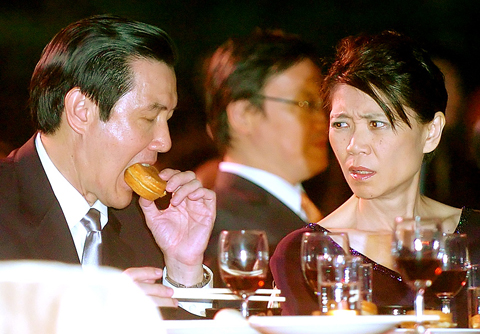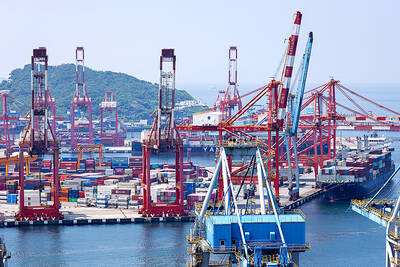They’re sweet, tasty, and are one of the most popular snacks in Taiwan, but unlike their beverage cousin — bubble or pearl milk tea, which has gained popularity worldwide — few people outside Taiwan know what red bean cakes are.
Thick round cakes slightly bigger than golf balls, they are made of waffle-style batter, which is poured into round-shaped molds and then filled with red bean paste. When the two sides of a mold are pressed together, they form an easily portable snack that tastes best when eaten right away.
But even people from China, which shares a similar culinary heritage as Taiwan, hadn’t seen the snacks until they came to Taiwan.

PHOTO: CNA
That’s about to change.
Red-bean cake makers are hoping to take the snacks overseas and turn them into one of Taiwan’s best known products.
Their campaign is getting some help from President Ma Ying-jeou (馬英九), who is a huge red-bean cake fan, and has inadvertently raised the profile of the snacks since he took office in 2008.

PHOTO: LIU HSIN-DE, TAIPEI TIMES
In a widely shown picture taken at a Double Ten National Day party in 2008, Ma was caught putting a red-bean cake in his mouth while his wife Chow Mei-ching (周美青) stared at him.
During Ma’s trip to visit allies in the South Pacific region, red-bean cakes were prepared for guests at a party aboard a Navy vessel.
And on many other occasions — such as ceremonies, media interviews or visits to markets, Ma has been treated to red-bean cakes.
Red-bean cakes are believed to have originated from a Japanese dessert known as “Imagawayaki.” The desserts in Japan, which were first baked over 200 years ago, are often found at Japanese festivals or supermarket food courts.
However, the desserts have become much more widely available in Taiwan, where they can be found being made fresh on many streets. Long lines are often found outside famous red-bean cake stores.
“Red-bean cakes have been successfully localized in Taiwan,” said Andy Wu (吳恩文), a food critic and radio host of a food program, adding that the flavor of the cakes is mostly determined by the quality of the red beans.
“Although red beans from Pingtung County’s Wandan Township (萬丹) in southern Taiwan are smaller than Japanese ones, they have a richer flavor,” Wu said.
An owner of a red-bean cake shop said there are more than 5,000 red-bean cake vendors in Taipei City and county alone.
As red-bean cakes are popular throughout the country, many people — especially middle-aged, unemployed people, want to step into the business. All they need is the right machine.
One of the most successful makers is Wu Chin-yang, a former billionaire who lost his fortune in a failed investment and began to sell red-bean cakes late last year.
Wu sells up to 1,000 red-bean cakes a day in Taipei, at NT$10 apiece.
“I got to make something different to succeed in fierce competition,” said Wu, whose shop is located near the largest computer market in the city.
He spent several months inventing a machine to produce the cakes in a larger size — at about 7cm in diameter and 100g in weight.
He also asked for help from a Japanese relative — who owns a traditional bakery in Japan — to create a unique recipe so the treats will not lose crispness even when they become cold.
People from the US, South Africa, New Zealand and Italy have been so taken by his product that they have expressed interests in buying his machines and learning from him so they can sell red-bean cakes in their countries.
Meanwhile, the growing number of Chinese tourists has not only brought red-bean cake vendors more business, but also made Wu eye the vast Chinese market.
A local bank has asked Wu about the possibility of working together. It said it was willing to offer loans to Wu to expand his business into China if he could set up 100 vendors. In return, it wants him to put its logo on his machines.
Chen Jia-tse, a Taiwanese businessman working in southern China, said the outlook for the red-bean cake business is bright, especially as most people in southern China like to eat sweets.
“It is absolutely doable to sell a red-bean cake at 3 yuan [US$0.44] there,” Chen said, adding that a small cup of Taiwanese pearl milk tea is priced at least 8 yuan — nearly 50 percent higher than that it is in Taiwan.
Victoria Bi, a Chinese manager from Shanghai, said red-bean cakes were the most delicious thing she ate during a recent two-week visit.
“I have never seen such desserts in China, I really want to bring some red-bean cakes back to Shanghai, “ Bi said, adding that the price was surprisingly low.
However, it seems there is not much room for vendors to raise red-bean cake prices.
“My customers almost all disappeared after I raised the price by 20 percent,” said an owner of a renowned store, who was forced to restore the original price.
Unlike bubble tea, which has inspired people overseas to buy the tapioca ingredients to make the beverages at home, red-bean cakes might face challenges on the global market.
For one thing, many Westerners are not used to eating sweet beans, as they are much more accustomed to lentils or other bean being cooked in salty dishes.
Andy Wu said red-bean cakes usually taste better when hot, so they may not be easy to promote as take-away items.
If these obstacles can be overcome, however, fans hope red-bean cakes can take the culinary world by storm.

Nvidia Corp chief executive officer Jensen Huang (黃仁勳) on Monday introduced the company’s latest supercomputer platform, featuring six new chips made by Taiwan Semiconductor Manufacturing Co (TSMC, 台積電), saying that it is now “in full production.” “If Vera Rubin is going to be in time for this year, it must be in production by now, and so, today I can tell you that Vera Rubin is in full production,” Huang said during his keynote speech at CES in Las Vegas. The rollout of six concurrent chips for Vera Rubin — the company’s next-generation artificial intelligence (AI) computing platform — marks a strategic

REVENUE PERFORMANCE: Cloud and network products, and electronic components saw strong increases, while smart consumer electronics and computing products fell Hon Hai Precision Industry Co (鴻海精密) yesterday posted 26.51 percent quarterly growth in revenue for last quarter to NT$2.6 trillion (US$82.44 billion), the strongest on record for the period and above expectations, but the company forecast a slight revenue dip this quarter due to seasonal factors. On an annual basis, revenue last quarter grew 22.07 percent, the company said. Analysts on average estimated about NT$2.4 trillion increase. Hon Hai, which assembles servers for Nvidia Corp and iPhones for Apple Inc, is expanding its capacity in the US, adding artificial intelligence (AI) server production in Wisconsin and Texas, where it operates established campuses. This

Garment maker Makalot Industrial Co (聚陽) yesterday reported lower-than-expected fourth-quarter revenue of NT$7.93 billion (US$251.44 million), down 9.48 percent from NT$8.76 billion a year earlier. On a quarterly basis, revenue fell 10.83 percent from NT$8.89 billion, company data showed. The figure was also lower than market expectations of NT$8.05 billion, according to data compiled by Yuanta Securities Investment and Consulting Co (元大投顧), which had projected NT$8.22 billion. Makalot’s revenue this quarter would likely increase by a mid-teens percentage as the industry is entering its high season, Yuanta said. Overall, Makalot’s revenue last year totaled NT$34.43 billion, down 3.08 percent from its record NT$35.52

PRECEDENTED TIMES: In news that surely does not shock, AI and tech exports drove a banner for exports last year as Taiwan’s economic growth experienced a flood tide Taiwan’s exports delivered a blockbuster finish to last year with last month’s shipments rising at the second-highest pace on record as demand for artificial intelligence (AI) hardware and advanced computing remained strong, the Ministry of Finance said yesterday. Exports surged 43.4 percent from a year earlier to US$62.48 billion last month, extending growth to 26 consecutive months. Imports climbed 14.9 percent to US$43.04 billion, the second-highest monthly level historically, resulting in a trade surplus of US$19.43 billion — more than double that of the year before. Department of Statistics Director-General Beatrice Tsai (蔡美娜) described the performance as “surprisingly outstanding,” forecasting export growth